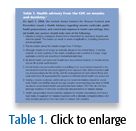Maintaining Personnel Health in the Dental Office
Standard precautions and monitoring disease outbreaks are part of an effective plan for keeping dental health care workers healthy.
 Infection prevention and control and the prevention of health care-associated infections in patients and injuries and illnesses in health care personnel are the goals of infection control.1-3 One of the principles of an effective infection control program is “Take Action to Stay Healthy.” Health care workers in good health are less likely to be vulnerable to emerging infections from patients and less likely to transmit infection. An effective personnel health program requires education and training; immunization programs; post-exposure management; medical conditions, work-related illness, and work restrictions; and health record maintenance, which were covered in the December 2008 issue. Following standard precautions and monitoring community-based disease outbreaks are also important parts of maintaining a personnel health program in the dental office.
Infection prevention and control and the prevention of health care-associated infections in patients and injuries and illnesses in health care personnel are the goals of infection control.1-3 One of the principles of an effective infection control program is “Take Action to Stay Healthy.” Health care workers in good health are less likely to be vulnerable to emerging infections from patients and less likely to transmit infection. An effective personnel health program requires education and training; immunization programs; post-exposure management; medical conditions, work-related illness, and work restrictions; and health record maintenance, which were covered in the December 2008 issue. Following standard precautions and monitoring community-based disease outbreaks are also important parts of maintaining a personnel health program in the dental office.
STANDARD PRECAUTIONS
In order to prevent personnel from unnecessary infectious risks, standard precautions should be followed, regardless of suspected or confirmed infection status of patients. A health history attempts to determine patients’ current health status, but may not be a valid tool to determine their infectious disease status. Individuals infected with some infectious diseases can be contagious prior to symptoms appearing. Dental health care personnel cannot, therefore, reliably determine the current infectious disease status of patients. This provides rationale for the use of standard precautions.1 Standard precautions are infection control measures used to prevent exposure to and transmission of pathogenic microorganisms, including bloodborne pathogens and other non-highly contagious microorganisms. Standard precautions should be used when there is anticipated occupational contact with all body substances except sweat and tears. These precautions apply to all patients in any setting where health care is provided , including oral health care settings. Standard precautions include: hand hygiene; use of gloves, gown, mask, and protective eyewear; and safe handling of sharp objects.1,3,4
TRANSMISSION-BASED PRECAUTIONS
Other infection control precautions are transmission-based. Transmission-based precautions are standard precautions plus additional precautions determined by the anticipated or known route of exposure of a highly contagious pathogen (eg, influenza, varicella, herpes simplex 1 and 2, tuberculosis). Transmission-based precautions are designed for patients documented or suspected to be infected or colonized with pathogens that require additional precautions beyond the standard precautions necessary to interrupt transmission.1,4
These precautions apply to airborne, droplet, and contact transmission. The precautions may be combined for diseases that have multiple routes of transmission. Whether singly, or in combination, they are always to be used in addition to standard precautions.4 Most dental practice settings are equipped for standard precautions, but not transmission-based precautions. Consultation with a hospital infection control practitioner may be indicated if a dental practice wishes to provide care using transmission-based precautions. In many instances, deferring elective dental treatment until the infectious diseases that require airborne precautions, eg, tuberculosis, chicken pox, etc, resolve and the patient is no longer contagious is recommended.1
DISEASE OUTBREAKS
Another important aspect of taking action to stay healthy would be to monitor any disease outbreaks in the community and to ensure that staff are adequately protected. For example, if the outbreak is related to a vaccine-preventable disease, review vaccination records and take proper precautions. See Table 1 for a recent measles outbreak that was reported by the Centers for Disease Control as a health advisory.
Additional information about measles and measles immunization can be found at www.cdc.gov/vaccines/vpd-vac/measles/default.htm and www.cdc.gov/ncidod/diseases/submenus/sub_measles.htm.
CONCLUSION
Following current CDC recommendations and incorporating evidence-based resources to create and keep up policies and procedures for personnel health can considerably reduce the risk of health-care associated infections in patients and illnesses in personnel. Visit the Organization for Safety and Asepsis Procedures’ website at www.osap.org for additional infection control resources, information, and tools.
REFERENCES
- Kohn WG, Collins AS, Cleveland JL, Harte JA, Eklund KJ, Malvitz DM, CDC. Guidelines for infection control in dental health-care settings—2003. MMWR Recomm Rep. 2003;19:1-61.
- Kohn WG, Harte JA, Malvitz DM, Collins AS, Cleveland JL, Eklund KJ. Guidelines for infection control in dental health-care settings—2003. J Am Dent Assoc. 2004;135:33-47.
- Boylard EA, Tablan OC, Williams WW, Pearson ML, Shapiron CN, Deitchman SD, Hospital Infection Control Practices Advisory Committee. Guideline for infection control in health care personnel, 1998. Am J Infection Control. 1998:26:289-354.
- Siegel JD, Rhinehart E, Jackson M, Chiarello L; Health Care Infection Control Practices Advisory Committee. 2007 Guideline for Isolation Precautions: Preventing Transmission of Infectious Agents in Health Care Settings. Am J Infect Control. 2007;35(10 Suppl 2):S65-164.
- Measles—United States, January 1 -April 25, 2008. MMWR Weekly. Available at: www.cdc.gov/mmwr/preview/mmwrhtml/mm5718a5.htm. Accessed December 15, 2008.
From Dimensions of Dental Hygiene. January 2009; 7(1):18-20.


